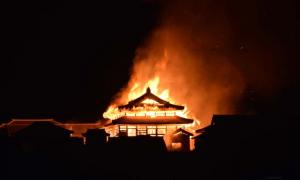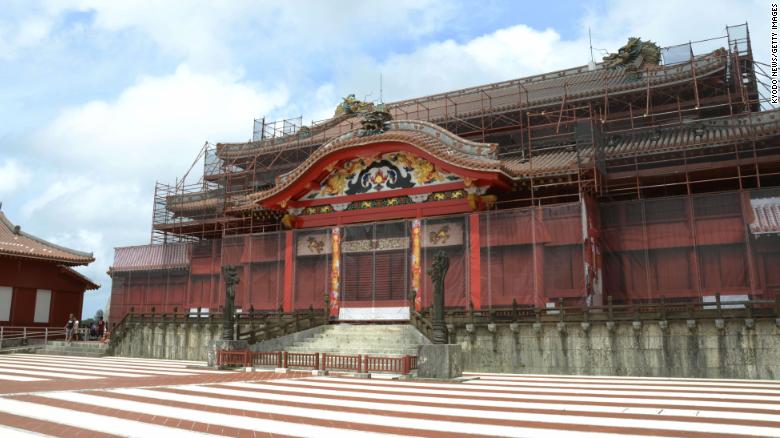https://wiki.samurai-archives.com/index.php?title=Shuri_castle#Gates
The first floor, called the shicha-gui (下庫理) in Okinawan, was mainly used for government matters, and for more public rituals and ceremonies in which the king himself participated[46] A series of sliding doors at the center of the front of the building opened directly onto the main audience chamber, or usasuka (御差床), above which (on the second floor) was the throne room. A throne sat here as well, where the king would sit to preside over government business, formal audiences and various rituals. Seats to his sides were reserved for the queen, their children, and royal grandchildren. The vermillion pillars to both sides of the throne were adorned with paintings of gold dragons and multi-colored clouds; hanging scroll paintings of kirin and phoenixes flanked the throne as well[46].
Deeper into the palace, to the east beyond the rear garden, were additional buildings such as the Yohokoriden (世誇殿) and Kanegura (金蔵); in the deepest portion of the palace, beyond the Hakuginmon gate, lay a space known as the shinbyôden (寝廟殿), and a viewing tower known as the Higashi-no-azana.[19][50] The Yohokoriden was the chief residence of royal princesses, but on the occasion of a king's death, the Crown Prince's accession ceremonies were held here. Meanwhile, the king's body would be carried into the shinbyôden via the hakuginmon ("Silver Gate," 白銀門), and would be laid there in state for a period.
- Seiden – the "West Hall", also called the State Palace, was situated to the east of the Una, but facing west towards China, and contains the throne room and royal living and ceremonial areas. The western facade includes two 4.1 meter high Dai-Ryu Chu (Great Dragon Pillars), crafted of sandstone from Yonaguni Island, and symbols of the king. The left dragon is called Ungyou, and the right is Agyou, and these motifs are replicated throughout the building including the roof. Other decorative elements include botan (peony flowers), shishi (golden dragons), and zuiun (clouds). The Shichagui (first floor) was where the king personally conducted affairs of state and ceremonies. The Usasuka was the lower area in front of where the king sat, with the Hira-usasuka (side-areas) flanking either side. The second floor included the Ufugui, the area for the queen and her attendants, and the Usasuku, the upper main throne room of the king. Behind it are the Osenmikocha, chambers where the king would pray daily. According to historical records, the Seiden was burned down and rebuilt four times (most recently in 1992), and was also used as the prayer hall for a Shinto shrine between 1923-1945.



No comments:
Post a Comment